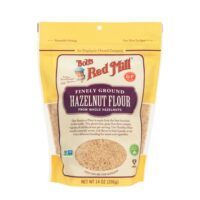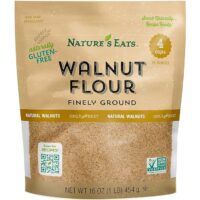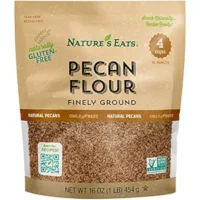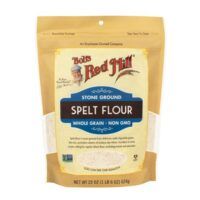
Healthier flours for stable blood sugar
Swapping white or wheat flour for these alternatives can add protein, fiber, and nutrients to your diet—and protect against big blood sugar swings.
The flour aisle at the supermarket is filled with a variety of options: From grains like spelt, barley, and oat to nuts like almonds and pecans, almost anything can be ground up and used to make pancakes, muffins, and more.
Some of these are delicious lower-carb replacements for regular wheat flour, which can raise blood sugar levels and impair metabolic health, when consistently consumed in large amounts. But not all of these seemingly “healthy” flours are truly better for you. Some have nearly as many carbs as white flour. Plus, each flour has its own texture and flavor that works well in certain recipes but not others. For example, almond flour often leads to denser and less fluffy than traditional flour, so it works less well in cakes and muffins.
So, which flour should you pick? Read on to learn how these wheat alternatives measure up.
The Problem With Typical Flour
Regular wheat flour is made by milling the grain, which is made of three parts. During this process, two of those—the germ and bran—get stripped away, leaving only the more chewable endosperm. But the bran contains fiber and the germ contains fat, both of which help slow down glucose absorbption.
White flour—which includes all-purpose, bread, and cake flours—is made with only this soft middle endosperm layer, so it doesn’t contain the same fiber, vitamins, and minerals that whole-grain wheat does. And without fiber to slow digestion, your body rapidly turns the refined carbs in white flour into blood sugar. This can cause a blood glucose spike and crash, and leave you feeling drained in the short-term.
Over time, repeating this roller coaster on a regular basis can take a toll on your metabolic health. One review of research showed that eating a diet high in refined carbs, such as white flour, may increase the risk of metabolic syndrome by 37 percent compared to eating whole grains.
Whole-wheat flour contains more fiber, because some or all of bran layers are added back in. But because this flour is still pulverized, it can have a high glycemic index (a measure of how quickly a food raises blood sugar). Experts say that’s because it’s easier for your digestive enzymes to break down the smaller pieces of processed grains compared to larger whole grains.
Per quarter-cup serving, wheat flour contains:
-
White flour: 114 calories, >1 g fat (0 g sat), 24 g carbs, >1 g fiber, 0 g sugars, 3 g protein, 24 g net carbs (the amount of carbs that impact blood sugar)
-
Whole-wheat flour: 102 calories, >1 g fat (0 g sat), 22 g carbs, 3 g fiber, 0 g sugars, 4 g protein, 19 g net carbs
6 Alternative Flours That May Be Better for Blood Sugar
Individual blood glucose responses will vary, but the following flours are made from nuts or beans, so they’re gluten-free and lower in carbs than wheat flour. You can usually find them at specialty grocery stores or online, or you can make your own at home.
 Hazelnut flour
Hazelnut flour
Per serving (1/4 cup): 180 calories, 14 g fat (1 g sat), 8 g carbs, 8 g fiber, 0 g sugars, 4 g protein, 0 g net carbs
Low in carbs and high in fiber, this rich, nutty flour also delivers protein, healthy fats, and inflammation-fighting vitamin E. Hazelnut flour is denser than most other flours, so it’s often mixed with almond or coconut flour to create a fluffier texture. It has a sweet, buttery flavor that works well in desserts such as biscotti and pie crusts.
Almond flour
Per serving (1/4 cup): 160 calories, 14 g fat (1 g sat), 6 g carbs, 4 g fiber, 2 g sugars, 6 g protein, 2 g net carbs
Almond flour is one of the most popular flour alternatives, and for good reason: It has a fine texture similar to wheat flour, but packs in twice as much protein and is unlikely to spike blood sugar. A quarter-cup serving also delivers around 20 percent of the RDI for magnesium. This key mineral helps your body use energy and regulate blood sugar. Because almond flour’s fat content adds moisture, it works well as a one-to-one swap in tender baked goods like pancakes and muffins.
 Walnut flour
Walnut flour
Per serving (1/4 cup): 133 calories, 13 g fat (1 g sat), 3 g carbs, 1 g fiber, 0 g sugars, 3 g protein, 2 g net carbs
Walnuts are loaded with heart-healthy omega-3 fats, which can reduce inflammation and improve insulin sensitivity. One study found that people who ate roughly 1.5 ounces of walnuts a day had better markers of metabolic health, such as glucose and cholesterol levels, after four months. Research shows that walnut flour contains a good portion of the healthy fats and antioxidants as the nuts themselves. Walnut flour has an earthy flavor and, compared to almond flour, a coarser texture that can weigh down baked goods. Start by replacing about a third of your regular flour for walnut, and adjust from there.
 Pecan flour
Pecan flour
Per serving (1/4 cup): 133 calories, 15 g fat (1 g sat), 3 g carbs, 1 g fiber, 1 g sugars, 1 g protein, 2 g net carbs
Pecan flour has a nutty, slightly maple flavor that enhances both sweet and savory recipes. It also adds a good dose of magnesium, and iron. According to one study, eating a pecan-rich diet may protect against insulin resistance and improve insulin levels. Experts say that the healthy fats, fiber, and protein in the nuts may prevent blood sugar swings. Like other nut flours, pecan flour has a dense texture that works better in soft, tender baked treats.
Coconut flour
Per serving (1/4 cup): 120 calories, 3 g fat (3 g sat), 16 g carbs, 10 g fiber, 2 g sugars, 4 g protein, 6 g net carbs
At 10 grams per serving, coconut flour is loaded with fiber. Because your body can’t break down fiber, it slows digestion and the release of glucose into your bloodstream. This can help temper blood sugar spikes and keep you full for longer. Compared to nut- and bean-based flours, coconut flour has a low moisture content and mild coconut flavor, so it’s excellent for baking. It creates a fluffy, light texture.
Chickpea flour
Per serving (1/4 cup): 89 calories, 1.5 g fat (0 g sat), 13 g carbs, 2.5 g fiber, 2.5 g sugars, 5 g protein, 10.5 g net carbs
Common in Indian cuisine—where it’s called besan or gram flour—chickpea flour is lower in calories than other flours. At 13 grams per serving, it contains fewer carbs than white flour (24 grams) but more than many nut-based flours (3 to 16 grams). Chickpea flour has an earthy, nutty taste and thick texture that makes it a good binding agent, so use it as a substitute for breadcrumbs in meatballs and fritters. Traditionally, chickpea flour is used to make flatbreads (farinata in Italy) and crepes (pudla in India).
Flours to Consider (With Caution)
Although these flours have nutritional benefits, they contain a higher amount of carbs. Many have nearly the same amount—or more—than regular white flour, which can set off a blood sugar surge.
 Spelt flour
Spelt flour
Per serving (1/4 cup): 110 calories, 0 g fat (0 g sat), 23 g carbs, 4 g fiber, 0 g sugars, 4 g protein, 19 g net carbs
An ancient type of wheat, spelt has a pleasant, nutty taste. It also has a similar texture and consistency as white flour, making it a higher-fiber (3 grams more per serving), higher-protein, and higher-potassium swap.
Amaranth flour
Per serving (1/4 cup): 140 calories, 2 g fat (0 g sat), 25 g carbs, 4 g fiber, 1 g sugars, 5 g protein, 21 g net carbs
Technically a tiny seed, amaranth contains many minerals, such as magnesium and selenium, that help support metabolic function. A quarter-cup serving of the flour also provides almost half of the RDI of iron for a man and a quarter of a woman’s RDI. Getting enough iron may help protect your heart health and support energy levels. Amaranth has an earthy flavor and low moisture content, so it can add a chewy, crisp texture to breads, pizza doughs, and cookies.
Cassava flour
Per serving (1/4 cup): 110 calories, 0 g fat (0 g sat), 28 g carbs, 3 g fiber, 0 g sugars, 1 g protein, 25 g net carbs
Made from a root vegetable, cassava flour is gluten-free and adds a soft, fluffy texture. It has a mild flavor similar to wheat, so it works well as a substitution in most recipes. But cassava is high in carbs, serving up 4 grams more per quarter-cup serving than white flour. Watch your portions and pair the flour with sources of protein and healthy fat to prevent glucose spikes. Or try combining cassava with a high-protein nut flour.

Take control of your metabolic health
Levels helps you see how food and lifestyle affect your health through macro tracking, habit-building, and customized insights and advice. Levels members can also incorporate biomarker data like real-time glucose and metabolic blood testing for an even more personalized experience. Click here to get started with Levels.





